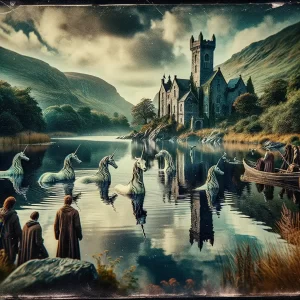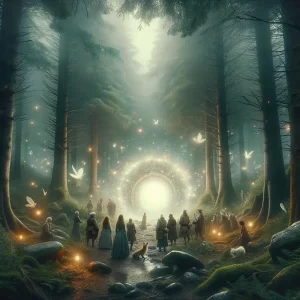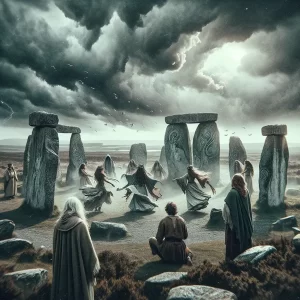Irish mythology is a rich and fascinating subject that has captured the imaginations of people for centuries. It is the body of myths and legends that are native to the island of Ireland. These myths were originally passed down orally in the prehistoric era and were part of the ancient Celtic religion. Later, many of these myths were written down in the early medieval era by Christian scribes, who modified and Christianized them to some extent.
The mythology of Ireland forms the basis of early Irish history and the structure of Gaelic society. It has stood the test of time, informing elements of Irish culture throughout its history. Unlike much Celtic mythology, the mythology of Ireland, its legends, its folklore, and mythical figures are still very much alive today. The stories of Irish folk heroes like Fionn Mac Cumhaill and Cúchulainn, as well as the tales of the Sidhe and other supernatural beings, continue to capture the imagination of people around the world.
Irish mythology is a complex and multifaceted subject that provides a window into the rich cultural heritage of Ireland. It is a subject that has been studied and explored by scholars, artists, and storytellers for centuries. Whether you are interested in the history of Ireland, the stories of its heroes and gods, or the supernatural beings that populate its folklore, Irish mythology is a fascinating topic that is sure to captivate your imagination.

Celtic Roots
Irish mythology has its roots in the ancient Celts, who were a group of Indo-European peoples that lived in Europe from the Iron Age to the Medieval period. The Celts were known for their rich culture, which included a complex system of beliefs, customs and traditions.
One of the most important aspects of Celtic culture was their religion, which was centered around the worship of nature and the elements. The Celts believed in many gods and goddesses, each of whom was associated with a particular aspect of nature, such as the sun, the moon, or the sea.
The Influence of Celtic Druidism
The Celts also had a class of priests known as Druids, who were responsible for maintaining the religious and cultural traditions of the Celtic people. The Druids were highly respected and held a position of great influence in Celtic society.
The Druids were believed to have possessed great knowledge and wisdom, and were skilled in the arts of divination and prophecy. They were also known for their ability to heal the sick and injured, and were said to have a deep understanding of the natural world.
The influence of Celtic Druidism can still be seen in Irish mythology today. Many of the gods and goddesses of Irish mythology are associated with nature and the elements, and the stories and legends that have been passed down through the generations often contain references to the wisdom and teachings of the Druids.
Mythological Cycles
The Mythological Cycle is a collection of tales and poems about the god-like Tuatha Dé Danann and other mythical races such as the Fomorians and Fir Bolg. These stories are based on Ireland’s pagan deities and are conventionally grouped into cycles. The Mythological Cycle is one of the oldest and most well-known collections of stories in history, influencing cultures throughout early Europe and into the modern day.
According to legend, the people of the goddess Danu, known as the Tuatha Dé Danann, arrived in Ireland in a series of invasions dating back over thousands of years. Much of the cycle relates to the exploits of these god-like people. The stories in the Mythological Cycle are full of adventure, great battles, voyages, and invasions and were originally written down in the Book of Invasions.
The four main cycles of Irish mythology are the Mythological Cycle, the Finn Cycle, the Ulster Cycle, and the Historical Cycle. The Mythological Cycle is the first and most important cycle, as it sets the stage for all the other cycles. It tells the stories of ancient Irish gods and godlike people.
The Fenian Cycle is another important cycle of Irish mythology. It is a collection of stories about the legendary warrior Fionn mac Cumhaill and his band of warriors, the Fianna. These stories are full of adventure and heroism, and Fionn is often depicted as a wise and just leader.
The Historical Cycle is the final cycle of Irish mythology. It tells the stories of Ireland’s kings and heroes from the earliest times up until the coming of Christianity. These stories are often based on historical events and are full of intrigue, betrayal, and war.

Key Characters
Gods and Deities
Irish mythology is rich with gods and deities, each with their own unique powers and stories. The most notable among them are Dagda, Lir, and Lugh. Dagda is the god of life and death, fertility, agriculture, and knowledge. He is often depicted as a large man with a club. Lir is the god of the sea and is associated with the Tuatha Dé Danann. Lugh is the god of the sun, light, and crafts. He is often depicted as a warrior with a spear.
Kings and Warriors
Irish mythology is full of powerful kings and warriors, each with their own unique stories. As stated earlier Fionn Mac Cumhaill, also known as Finn Maccool, is one of the most famous. He was the leader of the Fianna, a group of warriors who protected Ireland. Cu Chulainn is another famous Irish warrior. He was known for his incredible strength and bravery in battle.
Irish Myth Heroes and Legends
Irish mythology is also filled with heroes and legends, each with their own unique stories. One of the most famous is the legend of the Children of Lir. In this story, four siblings are turned into swans by their stepmother and forced to live for 900 years before being turned back into humans. Another famous legend is the story of Cuchulainn and the Cattle Raid of Cooley. In this story, Cuchulainn defends Ulster from an invading army.
Folklore and Tales
Leprechauns and Other Creatures
Ireland is famous for its folklore and tales of mythical creatures. One of the most well-known creatures is the leprechaun. These small, mischievous beings are said to be shoemakers who hide their gold at the end of a rainbow. If caught by a human, they have the power to grant three wishes in exchange for their freedom.
Another creature from Irish mythology is the Púca. This shape-shifting spirit can take on many forms, including a horse, goat, or even a human. It is known for its trickery and often leads people astray or causes mischief. The Sidhe, or fairy folk, is one of the most important Irish folklore characters. They are said to reside in Tír na nÓg, the land of eternal youth, and can be both helpful and dangerous to humans.
Folk Tales and Stories
Irish folklore is rich in stories and tales that have been passed down through generations. One famous tale is that of Balor of the Evil Eye, a giant who had the power to kill with a single glance. Another well-known figure is the Banshee, a female spirit who wails when someone is about to die.
The Oilliphéist, a giant serpent, is also a prominent figure in Irish mythology. It was said to have terrorized the countryside until it was finally defeated by the hero Fionn Mac Cumhaill. The Abhartach, known as the Irish vampire, is another creature from Irish folklore. Legend has it that he rose from his grave to terrorize his village until he was finally defeated by a brave warrior.
Influence of Christianity
Christianity had a significant impact on Irish mythology, especially during the Middle Ages. Christian monks and scholars recorded ancient Irish myths, but with the bias of faith. As a result, Christian development and ancient mythology significantly influenced each other.
The most notable influence of Christianity on Irish mythology was the conversion of pagan beliefs to Christianity. Missionaries, most famously Saint Patrick, converted the Irish tribes to Christianity in quick order, producing a great number of saints in the Early Middle Ages, and a faith that would continue to shape Irish culture for centuries.
One of the most significant aspects of this conversion was the adoption of Christian saints into Irish mythology. For example, Ireland’s two patron saints, St. Patrick and St. Brigid, are rooted in ancient Irish mythology. St. Brigid of Kildare is said to be rooted in the Celtic Goddess Brigid. St. Patrick, the patron saint of Ireland, is said to have used the shamrock to explain the Holy Trinity to the Irish, and St. Brigid, a Christian nun, was said to have been born on the same day as the pagan goddess Brigid.
Christianity also influenced the way that Irish mythology was recorded and transmitted. Christian monks played a significant role in the preservation and transmission of Irish mythology, and many of the surviving texts were written by Christian scribes. These scribes often added Christian elements to the stories they recorded, such as the introduction of Christian themes and symbols.

Ancient Texts and Manuscripts
Irish mythology is a rich and complex tapestry of stories, legends, and beliefs that have been passed down through generations. Much of what is known about Irish mythology comes from ancient texts and manuscripts that have been preserved over the centuries. These texts provide a fascinating glimpse into the beliefs, customs, and traditions of the ancient Irish people.
The three main manuscript sources for Irish mythology are the Book of the Dun Cow, the Book of Leinster, and the Book of Invasions. The Book of the Dun Cow is the oldest surviving manuscript written entirely in the Irish language and dates back to the late 11th/early 12th century. It is held in the library of the Royal Irish Academy. The Book of Leinster, which is in the Library of Trinity College, Dublin, dates back to the early 12th century and contains a wealth of information about Irish mythology, history, and law. The Book of Invasions, also known as Leabhar Gabhála, is a collection of stories that trace the ancestry of the Irish people back to ancient times.
Other important manuscripts include the Yellow Book of Lecan, the Great Book of Lecan, and the Book of Ballymote. These manuscripts contain a wealth of information about Irish mythology, history, and culture. They provide valuable insights into the beliefs, customs, and traditions of the ancient Irish people.
In addition to these manuscripts, there are also many texts and documents that have been preserved in various archives and libraries around the world. These include the Annals of the Four Masters, the Annals of Ulster, and the Annals of Inisfallen. These texts provide valuable historical information about Ireland and its people.
The University College Cork (UCC) also houses a large collection of ancient Irish manuscripts, including the Book of Fermoy, the Book of Lismore, and the Book of Mac Carthaigh Riabhach. These manuscripts contain a wealth of information about Irish mythology, history, and culture.
Geographical Influence
The landscape of Ireland has played a significant role in shaping the mythology of the country. Many of the ancient tales and legends are closely tied to specific geographical locations, such as mountains, rivers, and lakes.
For instance, the province of Ulster is home to the famous tale of Cú Chulainn, one of the legendary Celtic mythology heroes, who defended Ulster against invaders. The story is set in the region’s rugged landscape, with the hero’s stronghold located at the base of the Slieve Gullion mountain.
Similarly, the province of Leinster is associated with the ancient goddess Danu, who is said to have given birth to the Tuatha Dé Danann, the mythical race of beings who ruled Ireland before the arrival of humans. The name Leinster itself is believed to be derived from the Irish word Laigin, which means “descendants of Danu.”
The province of Meath is considered the center of Ireland and is home to the Hill of Tara, the ancient capital of the country. Many of the myths and legends associated with Meath are tied to this hill, which was believed to be the seat of the High Kings of Ireland.
The province of Connacht is the setting for many of the tales of the legendary warrior queen, Maeve. The landscape of Connacht is characterized by rugged mountains and wild coastlines, which are said to have inspired the fierce and independent spirit of the queen.
Munster, the southernmost province of Ireland, is associated with the goddess Ériu, who is said to have given her name to the country itself. The region is also home to the famous Rock of Cashel, a medieval fortress that was believed to have been the seat of the kings of Munster.
From the rugged mountains of Ulster to the rolling hills of Meath, each region has its own unique stories and legends that reflect the landscape and the people who have lived there.
Frequently Asked Questions
What are some common Irish mythical creatures?
Irish mythology is full of fascinating creatures, some of which have become well-known beyond Ireland’s borders. The most famous of these is probably the leprechaun, a small, mischievous fairy who is said to grant wishes to those who catch him. Other popular creatures include the banshee, a female spirit who foretells death, and the selkie, a seal who can transform into a human. The puca, a shape-shifting creature, is also well-known, as is the changeling, a fairy child who is swapped with a human child.
What are some interesting facts about Irish mythology?
Irish mythology is one of the oldest mythologies in Europe, with roots dating back to the pre-Christian era. It is rich in stories of gods, heroes, and magical creatures, and is known for its complex and intricate narratives. One interesting fact is that many of the stories were passed down orally for centuries before they were written down, which has led to variations in the tales. Another fascinating aspect is the role of women in Irish mythology, with many powerful goddesses and female heroes featured prominently.
What is the difference between Irish mythology and Celtic mythology?
Irish mythology is a subset of Celtic mythology, which encompasses the myths and legends of the Celtic peoples across Europe. While there are similarities between the two, Irish mythology is distinct in its focus on the gods and heroes of Ireland, and its incorporation of Christian elements after the arrival of Christianity in Ireland.
To learn more about Irish mythology, check out this great video below:


